|
Report from
Europe
No end in sight to slump in EU tropical wood imports
Total EU27 imports of tropical wood and wood furniture
of 954,200 tonnes in the first eight months of 2024 were
14% less than during the same period in 2023.
After imports fell to just under 110,000 tonnes in June, the
third lowest monthly total ever recorded, they briefly
recovered to 136,000 tonnes in July before falling again to
110,000 tonnes in August (Chart 1a).
EU tropical wood and wood furniture import quantity this
year remains on course to be at the lowest level since the
EU was first formed (as the EEC) in 1957.
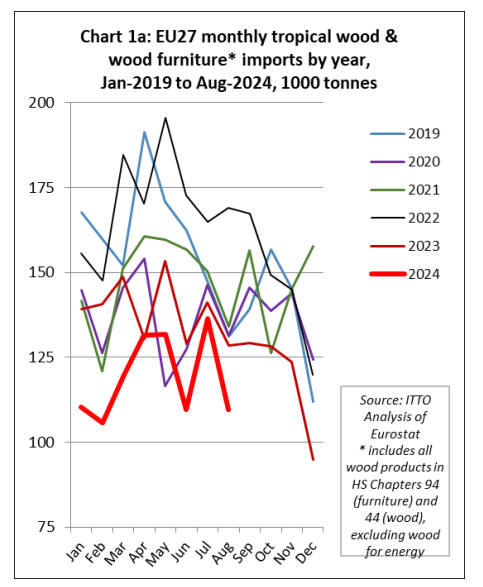
The trade figures look a little healthier when considered in
value terms. In the first eight months of 2024, the EU27
imported tropical wood and wood furniture with total
value of US$2033 million, 10% less than the same period
in 2023.
More positively, monthly import value of US$255 million
in June, US$268 million in July, and US$243 million in
August were not far short (at least in nominal terms) of the
import value for these same months in 2018 and 2019,
before the pandemic (Chart 1b).
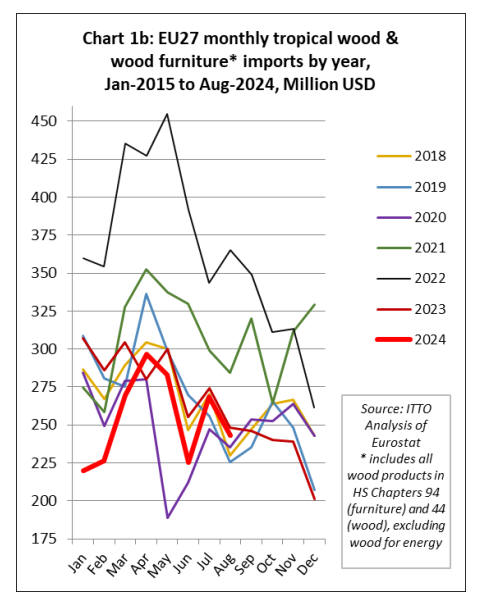
IMF foresee only modest medium-term economic
growth in Europe
The historically slow pace of tropical wood product
imports into the EU is occurring against the background of
subdued and uncertain economic conditions in the region.
The IMF, in presenting their latest European Economic
Outlook report on 24 October, suggested that Europe's
recovery is falling short of its full potential and the
medium-term outlook is no better.
The IMF foresee only a modest increase in growth for
2024 and 2025. IMF project that the eurozone will grow
by just 0.8% in 2024, a 0.1% decrease compared to July's
outlook. For 2025, the euro area's growth is expected to
pick up slightly to 1.2%, but the forecast has been reduced
by 0.3%.
Among Europe's largest economies, Germany and Italy are
projected by the IMF to significantly underperform.
Germany's economy is forecast to contract by 0.3% in
2024, with growth flatlining at 0% in 2025. Italy is
expected to grow by 0.7% in 2024, unchanged from July's
estimates, with a slight decline to 0.6% in 2025. While
Italy is expected to benefit from the EU-financed National
Recovery and Resilience Plan, Germany faces the
combined pressures of fiscal consolidation and a sharp
decline in property prices, both of which are expected to
dampen its economic performance.
In contrast, Spain stands out as a top performer with its
IMF growth forecast for 2024 revised up by 0.5% to 2.7%,
and a steady 2.9% growth anticipated in 2025. France is
projected to maintain stable growth of 1.1% in both 2024
and 2025, although IMF’s forecast for 2025 has been
slightly downgraded by 0.2%.
On inflation, IMF expect the European Central Bank to
sustainably reach its 2% rate target by mid-2025. For most
Central and Southern European (CESEE) countries, IMF
expect that target rates will not be reached before 2026.
The IMF is recommending that central banks pursue a
smooth loosening path in advanced European economies
and that they be more careful and ease more cautiously in
several CESEE countries, as real wages may outpace
productivity growth there. IMF also recommend
tightening the fiscal stance across most of Europe. While
IMF is expecting a recovery, it suggests that deficits are
too large to stabilize public debt.
According to IMF, the good news is that the EU has
agreed on a fiscal rules’ framework addressing
sustainability concerns while allowing for investment in
green transitions and infrastructure. IMF also note that a
key reason why Europe is seeing moderate recovery this
year is that it is coming out of the large energy price shock
that followed on from Russia’s invasion of Ukraine in
February 2022.
Germany has been particularly affected by this shock
because of its energy intensive manufacturing. Continuing
uncertainty created by Russia's war in Ukraine is an
important factor leading IMF to moderate their
expectations for European growth next year.
However, IMF also suggest there are other longer-term
structural issues impeding Europe’s economic
performance. IMF observe that compared to the U.S.,
income per capita in Europe is now 30% lower and the gap
has remained unchanged for two decades. At the turn of
the century that gap did not exist.
IMF identifies three factors holding Europe back. First,
Europe markets are too fragmented to provide the needed
scale for firms to grow. Second, Europe has no shortage of
savings, but its capital markets fail to provide to boost
young and productive firms. In addition, Europe is missing
skilled labor where it is needed.
The IMF suggest a deeper, more integrated Single Market
can resolve most of these issues. This means removing the
barriers that still prevent goods, services, capital, and labor
to flow freely between countries.
New construction in Europe orders continue to fall
steeply
The weakness of the EU construction sector continues to
be a significant concern for the EU’s timber industry.
Forward-looking indices show that EU construction
activity has remained weak and that new orders continue
to fall steeply. The HCOB Eurozone Construction PMI
Total Activity Index — a seasonally adjusted index
tracking monthly changes in total industry activity — rose
from 41.4 in August to 42.9 in September, indicating a
softer but still large contraction in activity across the euro
area construction sector.
The latest downturn extended the current sequence of
falling construction activity to 29 months.
According to the HCOB report, negative output trends
reflected further declines across the three largest eurozone
economies in September. French construction activity saw
the steepest reduction, and at the fastest pace since May
2020.
German and Italian firms also saw activity decrease,
although the rate of decline was slightly slower than in
previous months. Lower output was also broad-based in
nature across the three monitored sectors covered by the
report. Housing activity saw the most pronounced
decrease, though falls in commercial and civil engineering
activity were also relatively strong.
EU27 tropical wood furniture imports make up for
earlier decline
After a very slow start to the year, EU wood furniture
imports from tropical countries continued to make up lost
ground in during the summer months. In the first eight
months of the year, the EU27 imported 351,600 tonnes of
wood furniture from tropical countries with a total value of
US$822 million. Import quantity and import value were up
7% and 3% respectively compared to the same period in
2023.
In the first eight months of this year compared to the same
period in 2023, EU27 import value of wood furniture
increased from Vietnam (+9% to US$353.1 million), India
(+11% to US$170.8 million), Malaysia (+21% to US$60.3
million), and the Philippines (+7% to US$5.6 million).
However, import value fell from Indonesia (-12% to
US$215.5 million), Thailand (-34% to US$9.4 million),
and Mexico (-15% to US$2.4 million). EU27 wood
furniture imports from all other tropical countries were
negligible during the period (Chart 2).
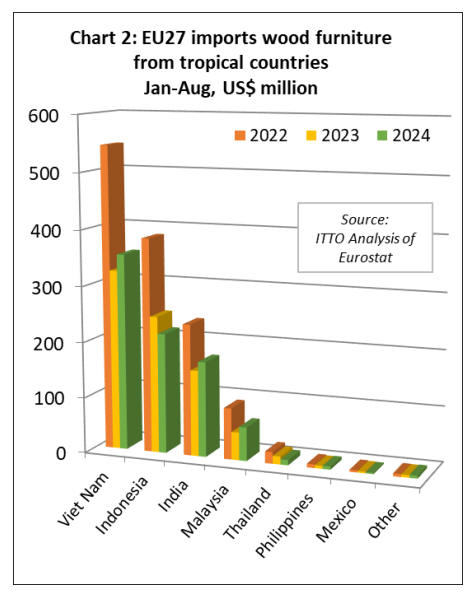
EU27 imports of tropical sawnwood down 19% in the
first eight months of 2024
The EU27 imported 371,600 cu.m of tropical sawnwood
in the first eight months of this year, 19% less than the
same period in 2023. Import value of this commodity was
US$435.8 million in the January to August period this
year, 20% less than the same period in 2023.
Imports declined from nearly all leading supply countries
during the period including Cameroon (-19% to 176,400
cu.m), Gabon (-25% to 70,600 cu.m), Brazil (-21% to
59,300 cu.m), Republic of Congo (-23% to 47,700 cu.m),
Malaysia (-8% to 42,300 cu.m), Ghana (-28% to 10,700
cu.m), Côte d’Ivoire (-29% to 6,400 cu.m), Suriname
(-30% to 4,900 cu.m) and the Central African Republic
(-53% to 4,100 cu.m).
Sawnwood imports from Ecuador bucked the overall
downward trend in the first half of this year, at 12,200
cu.m, up 43% compared to the same period in 2023 (Chart
3).
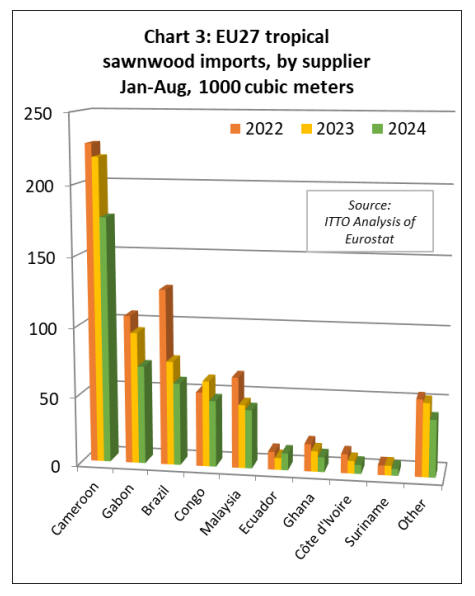
The EU27 imported 88,600 tonnes of tropical
mouldings/decking in the first eight months of this year,
12% less than in the same period in 2023. Import value of
this commodity was down 20% to US$154.7 million in the
same period.
During the first eight months, imports increased year-on-
year from Peru (+6% to 8,900 tonnes) but fell from all
other leading supply countries including Brazil (-20% to
30,800 tonnes), Indonesia (-2% to 28,000 tonnes), Gabon
(-18% to 6,100 tonnes), Malaysia (-3% to 4,200 tonnes),
and Bolivia (-18% to 3,600 tonnes) (Chart 4).
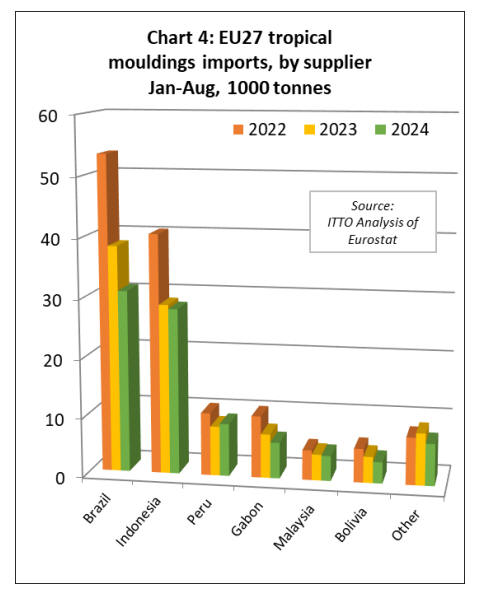
The EU27 imported 25,100 cu.m of tropical logs with a
total value of US$15.3 million in the first eight months of
this year, respectively 60% and 62% less than in the same
period last year. The decline was driven mainly by an 90%
decline in imports from the Republic of Congo to 3,100
cu.m.
This follows the ban on exports of most logs from the
country since 1st January 2023. EU27 imports of logs in
the first eight months of this year were also down
compared to the same period last year from the Central
African Republic (-39% to 6,900 cu.m), the Democratic
Republic of Congo (-14% to 5,000 cu.m), Cameroon (-
47% to 3,600 cu.m), and Guyana (-40% to 800 cu.m).
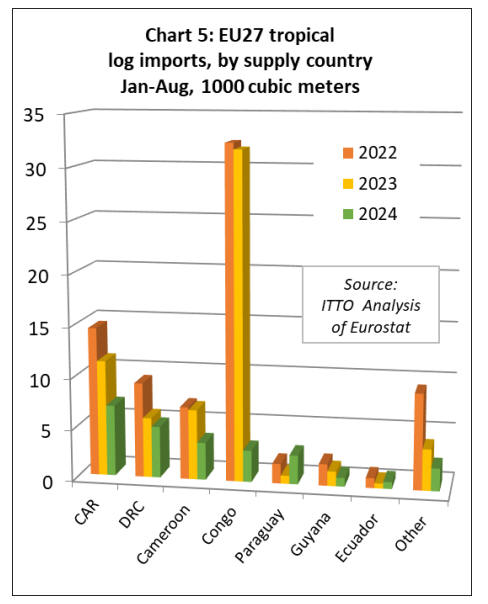
However, EU27 log imports increased from Paraguay
(+259% to 2,800 cu.m), and Ecuador (+38% to 700 cu.m)
during the eight-month period (Chart 5 above).
EU27 imports of tropical hardwood veneer, plywood
and joinery down sharply
The EU27 imported 159,800 cu.m of tropical veneer with
a total value of US$108.5 million in the first eight months
of this year, down 17% and 18% respectively compared to
the same period last year. Imports of tropical veneer from
Gabon, by far the largest supplier to the EU27, were
89,500 cu.m in the first eight months of this year, 12% less
than the same period in 2023.
EU27 imports of this commodity also decreased during the
period from Côte d'Ivoire (-20% to 32,400 cu.m),
Cameroon (-30% to 16,600 cu.m), Indonesia (-14% to
2,000 cu.m), and Equatorial Guinea (-87% to 600 cu.m).
Veneer imports into the EU27 increased during the eight-
month period from the Republic of Congo (+29% to 7,300
cu.m), the UK (+28% to 4,700 cu.m), and Ghana (+2% to
4,500 cu.m). (Chart 6).

The EU27 imported 178,600 cu.m of tropical plywood
with a total value of US$129.0 million in the first eight-
months of this year, respectively 3% and 5% less than the
same period last year. Imports fell from the three leading
supply countries during the period including Indonesia (-
14% to 49,200 cu.m), Gabon (-12% to 40,000 cu.m), and
China (-8% to 21,600 cu.m).
Imports from Brazil were also down, by 9% to 10,000
cu.m, while indirect imports via the UK fell 32% to 4,800
cu.m. However, these losses during the eight-month period
were partly offset by rising imports from Vietnam (+108%
to 17,700 cu.m), Morocco (+26% to 12,800 cu.m),
Paraguay (+58% to 5,200 cu.m), and Malaysia (+65% to
4,500 cu.m) (Chart 7).
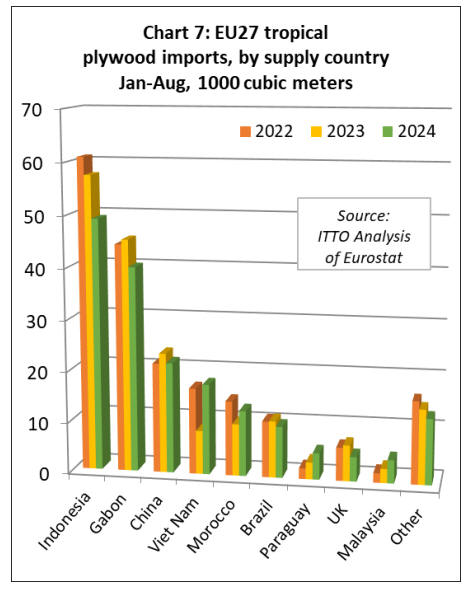
The EU27 imported 11,400 tonnes of tropical wood
flooring with a total value of US$29.7 million in the first
eight months of this year, down 21% and 29% respectively
compared to the same period in 2023. Imports of 5,400
tonnes from Malaysia in the eight-month period this year
were 26% less than the same period in 2023.
Flooring imports also fell from Indonesia (-39% to 2,100
tonnes) and Brazil (-41% to 400 tonnes). However,
imports increased from Vietnam (+40% to 2,800 tonnes)
(Chart 8).
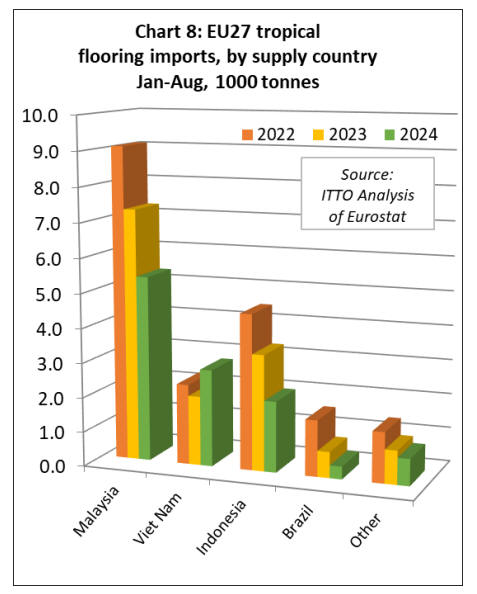
The value of EU27 imports of other joinery products from
tropical countries - which mainly comprise laminated
window scantlings, kitchen tops and wood doors was
US$132.7 million in the first eight months of this year.
This was down 3% compared to the same period in 2023.
Import quantity was also down 3% to 58,100 tonnes
during the same period.
Between January and August this year, EU27 import value
of other tropical joinery products was down 20% to
US$38.4 million from Malaysia. Indirect imports from the
UK also fell, by 18% to US$3.0 million.
However, import value increased 3% to US$53.6 million
from Indonesia and was up 34% to US$12.7 million from
Vietnam. In a potentially significant longer-term
development, given efforts in central Africa to shift up the
value chain as log exports are banned, EU import value of
laminated joinery products in the first eight months of
2024 was up 33% to US$8.5 million from the Republic of
Congo and up 26% to US$2.1 million from Cameroon
(Chart 9).

Proposal to delay EUDR and new EUDR Guidance
Documents
On 2 October, the European Commission (EC) published a
proposal to delay application of the provisions of the EU
Deforestation Regulation (EUDR) for a period of 12
months to give concerned parties additional time to
prepare.
The proposal to delay was approved by the European
Council on 16 October. If the European Parliament now
approves the proposal in a vote scheduled for 14
November, EUDR would become applicable on 30
December 2025 for large companies and 30 June 2026 for
micro- and small enterprises.
If the European Parliament does not approve the proposal,
the start dates contained in the existing legal text – 30
December 2024 for large companies and 30 June 2025 for
micro- and small enterprises – would still apply.
The proposal to amend the start date does not affect the
substance of the already existing rules, which is to
minimise the EU’s contribution to deforestation and forest
degradation worldwide, by only allowing placing on the
EU market, or exporting from the EU, deforestation-free
products. Deforestation-free products are products that
have been produced on land not subject to deforestation or
forest degradation after 31 December 2020.
The EC proposal to amend the start date was published
alongside additional guidance documents and a stronger
international cooperation framework to support global
stakeholders, Member States and third countries in their
preparations for the implementation of the EUDR.
See:
https://ec.europa.eu/commission/presscorner/detail/en/ip_24_500
9
https://www.consilium.europa.eu/en/press/press-
releases/2024/10/16/eu-deforestation-law-council-agrees-to-
extend-application-timeline/
|